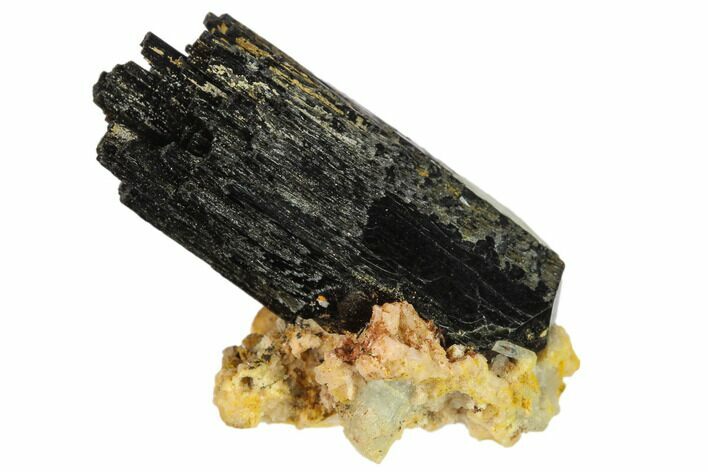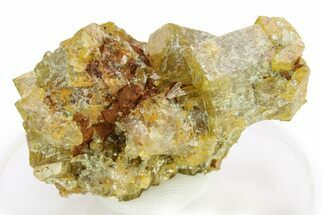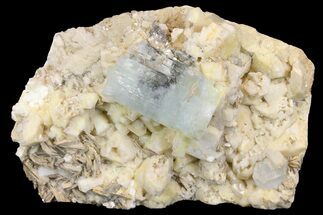This Specimen has been sold.
1.4" Black Tourmaline (Schorl), Aquamarine & Orthoclase - Namibia
This is an association of orthoclase feldspar, aquamarine and black tourmaline (schorl), collected from the Erongo Mountains in Namibia. Under short wave UV light, the feldspar fluoresces a vibrant pink-red color.
Schorl, also known as "black tourmaline" or "black schorl", is a black form of tourmaline that often occurs as lustrous prismatic crystals. The crystals can be stubby or elongated and typically feature lengthwise striations. Many schorl crystals have flattened pyramidal terminations. They can also form in radiating, columnar, and stalactitic aggregations, as well as small, needle-like inclusions within quartz (tourmalinated quartz) and in massive form.
Schorl is a basic sodium iron aluminum boro-silicate with the generic chemical formula NaFe2 + 3Al6(BO3)3Si6O18(OH)4 . It has been used for everything from jewelry to piezoelectric guitar pickups.
Schorl is a basic sodium iron aluminum boro-silicate with the generic chemical formula NaFe2 + 3Al6(BO3)3Si6O18(OH)4 . It has been used for everything from jewelry to piezoelectric guitar pickups.
Orthoclase is a feldspar mineral with the chemical formula KAlSi₃O₈ and a hardness of 6 - 6.5 on the Mohs hardness scale. It is considered a key component in many igneous rock formations and is one of the most abundant minerals throughout the continental crust. It can form individual crystals, but it is most commonly known for its pink coloration within granite rock. It has many commercial uses, including application in the production of a wide variety of ceramics, and is sometimes used in the manufacturing of glass.
Aquamarine is a blue-green variety of beryl. Oddly enough, it owes its color to iron(II) and iron(III) cations within the crystal lattice, of which iron(II) is responsible for the blue color, while iron(III) is responsible for the yellow color. The color vibrance and hue are dependent on the concentration of these cations, or lack of one or the other. The presence of both cations in the right position within the crystal lattice, can result in a deep blue colored crystal that is known as "maxixe".
Beryl is a mineral composed of beryllium aluminum cyclosilicate, with the chemical formula Be3Al2(SiO3)6. Naturally occurring beryl tends to form hexagonal crystals that can reach several meters in size if given the right conditions. Completely pure beryl will be transparent and colorless, while mineral impurities frequently tint the crystals color in most specimens.
Well known varieties of beryl include aquamarine and emerald, although beryl can also be green, blue, yellow, white and red, depending on the incorporated impurities during formation. Red beryl is its rarest form, and can currently only be found in New Mexico and Utah.
Well known varieties of beryl include aquamarine and emerald, although beryl can also be green, blue, yellow, white and red, depending on the incorporated impurities during formation. Red beryl is its rarest form, and can currently only be found in New Mexico and Utah.
SPECIES
Tourmaline var. Schorl, Beryl var. Aquamarine & Orthoclase Feldspar
LOCATION
Erongo Mountains, Namibia
SIZE
1.4" wide
CATEGORY
SUB CATEGORY
ITEM
#132177
 Reviews
Reviews













